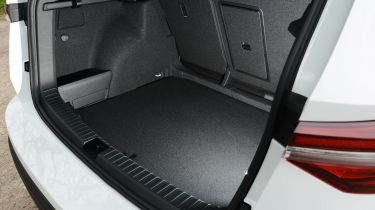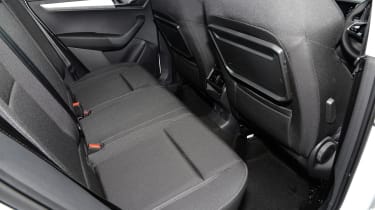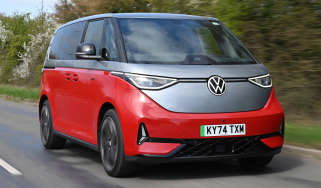Skoda Karoq - Practicality, comfort and boot space
A big boot, roomy cabin and clever touches make the Skoda Karoq a great family car choice

The Skoda Karoq has supportive seats, a roomy cabin, and a well-designed dashboard made with high-quality materials. All things considered, it’s an impressive effort.
The large interior and voluminous boot are well suited to family use, and there are plenty of well-thought-out details that make life a little easier, such as the little bins for the front doors, standard nets in the boot, a sunglasses holder, and an umbrella hidden in the driver’s door, so you’re always prepared despite our unpredictable weather. Provided you haven’t gone for the electric front seats with memory settings that come with the Convenience pack on SE L trim and above, you get foldout picnic tables on the backs of both front seats.
A space-saver spare is on the options list, as is a Rough Road pack that adds underbody protection if you plan on heading off-road. A reversing camera can be added to entry-level SE Drive, but comes as standard from SE L and above. A 360-degree camera system can be fitted to the top-of-the-range Sportline with the Parking Package plus option.
Size
The Karoq is noticeably bigger than its predecessor, the Yeti, and measures 4,382mm long, 1,841mm wide and 1,603mm tall. That compares with the 4,447mm length of the Peugeot 3008, or 4,425mm of the Nissan Qashqai, so it’s pretty much on par with its rivals.
Leg room, head room & passenger space
There’s good leg and headroom in any of the seats in the Skoda Karoq. Taller rear seat passengers may find their knees brushing on the seat backs even with the standard VarioFlex rear bench pushed as far back as it will go, but rear legroom is generally very good for the class.
Used - available now

2022 Skoda
Karoq
29,751 milesAutomaticPetrol1.5L
Cash £20,187
2022 Skoda
Karoq
1,780 milesAutomaticPetrol1.5L
Cash £18,100
2021 Skoda
Karoq
36,382 milesManualPetrol1.0L
Cash £12,000
2020 Skoda
Karoq
44,201 milesAutomaticDiesel1.6L
Cash £14,006The SE Drive and SE L versions of Karoq come with two ISOFIX points on the outer positions of the rear bench, while Sportline trim adds an additional point on the front passenger seat.
Boot Space
The two-wheel-drive Karoq has an impressive 521-litre boot with the rear seats in place or a huge 1,630-litre boot with them folded. Adding four-wheel drive drops these figures to 500 litres and 1,609 litres, respectively.
We’d recommend springing for the optional VarioFlex rear seats for around £800 if you can. This gives you sliding and reclining rear seats that are separated out into three individual chairs, making the Karoq much more flexible when having to carry both longer items and people at the same time. You can adjust the ‘seats up’ load area figure to 588 litres if you don’t need quite so much rear leg room, or you can completely remove the rear seats, increasing capacity to a van-like 1,810 litres.
The top-spec Sportline Karoq gets a tailgate that raises electrically, and there’s a ‘virtual’ boot release that allows you to open it with the waggle of a foot under the rear bumper if your hands are full.
Towing
The smallest 1.0-litre petrol can tow a decent 1,400kg braked trailer or caravan. This jumps to 1,700kg with the 1.5-litre, and 1,900kg with the 2.0-litre petrol with four-wheel drive.
If you really want the maximum towing capacity, then look toward the 2.0-litre diesel, which can tow a whopping 2,100kg, which is highly impressive for the class.












